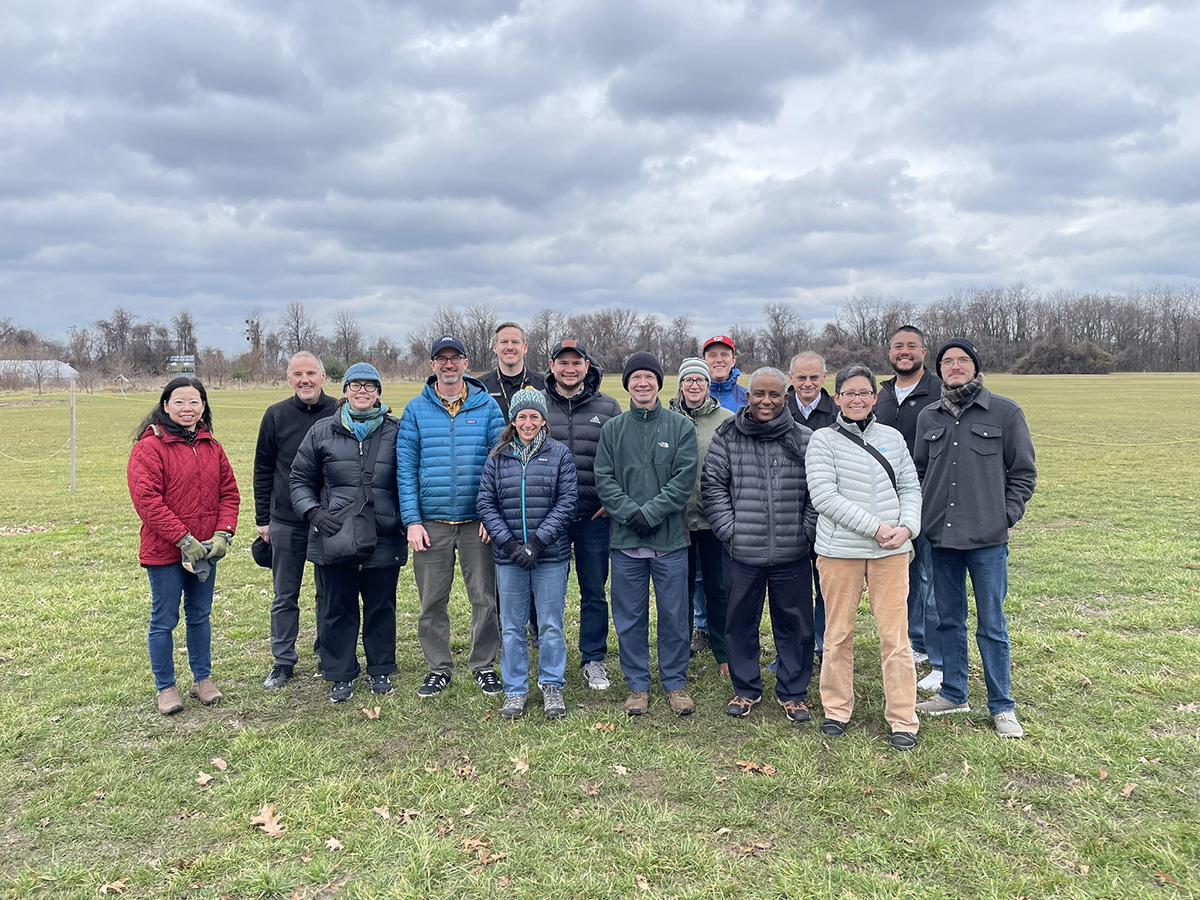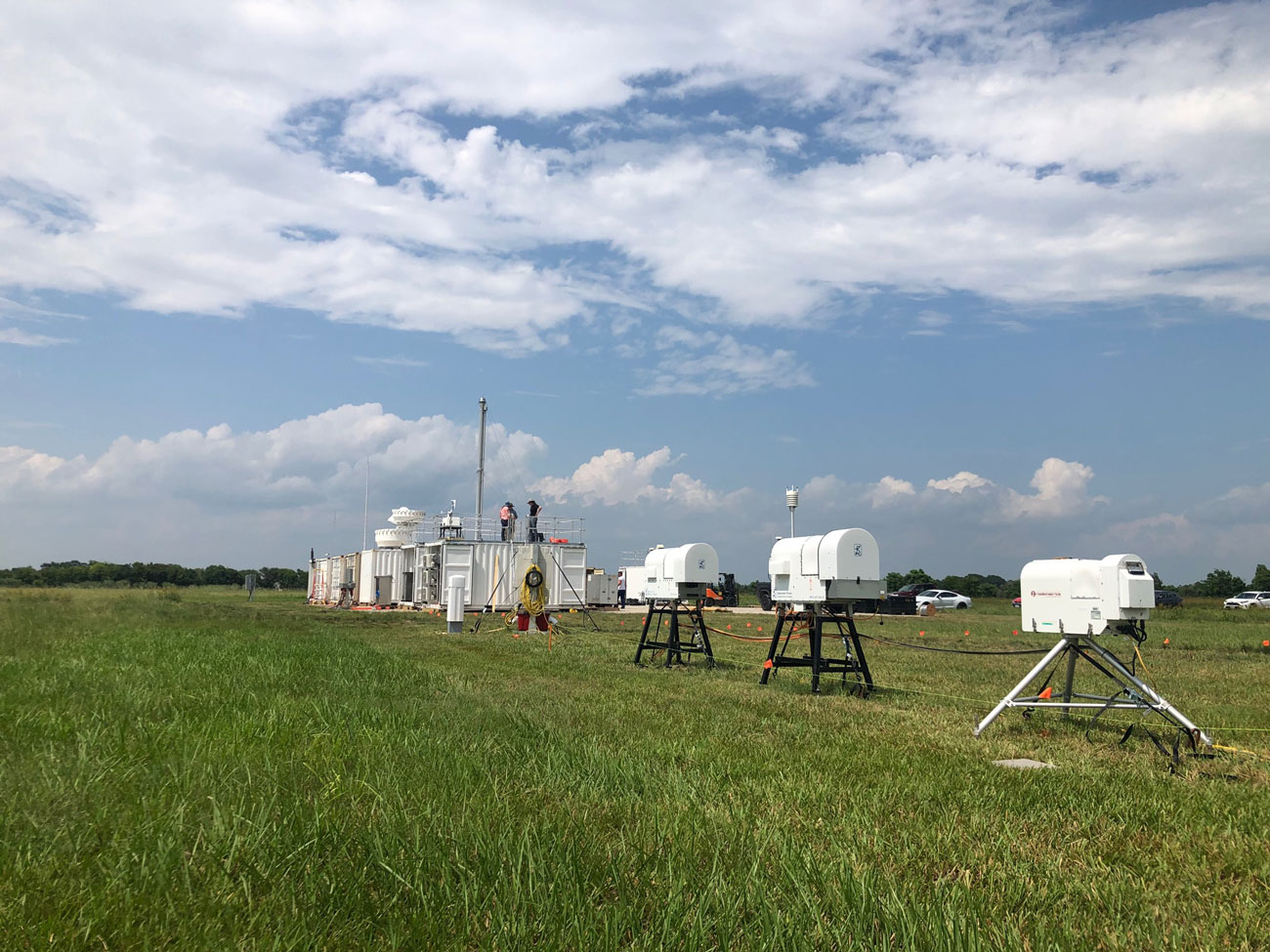A Field of Urban Dreams
Published: 23 February 2024
The 2024 annual meeting of the American Meteorological Society includes previews of ARM’s upcoming atmospheric campaign in Greater Baltimore

The word “courage” can mean the will to take direct action.
Spelled another way, CoURAGE is the Coast-Urban-Rural Atmospheric Gradient Experiment. Direct action is also the point.
A team of 27 investigators, led by Kenneth Davis of Pennsylvania State University, will soon spend a year measuring and characterizing the atmospheric environment of Baltimore, Maryland, and that of the mid-Atlantic region around the city.
The CoURAGE field campaign, slated to unfold from December 2024 through November 2025, will rely on continuous data from remote-sensing surface instruments in four locations: the city itself and three ancillary sites—one urban, one rural, and one on an island in Chesapeake Bay.
Instruments at three of the sites will be provided by the Atmospheric Radiation Measurement (ARM) user facility, managed by the U.S. Department of Energy (DOE) Office of Science.
ARM has three fixed-location atmospheric observatories across the world. It also deploys three containerized mobile observatories, one of which will operate near Baltimore’s city center as part of CoURAGE.
What Controls a City’s Microclimate?

The scientific motivation to take direct action during CoURAGE stems from the fact that earth system models are not yet well adapted to predict climate and weather variability within cities. One reason is the absence of robust atmospheric field data in urban environments.
It’s important to understand “how land use affects the climate at a neighborhood scale,” said Katia Lamer, a CoURAGE co-investigator from Brookhaven National Laboratory in New York. “CoURAGE will help us understand the main factors controlling Baltimore’s microclimate.”
She wants to know: Does the city itself strongly reshape the atmospheric boundary layer and cloud patterns? (The boundary layer is the part of the atmosphere closest to the Earth’s surface.) Or does the city only “slightly modify” patterns formed in upstream rural and coastal environments?
CoURAGE’s designers hope the campaign will help provide uniquely comprehensive measurements along a variety of urban environmental gradients. In turn, models will be better at predicting the impacts of climate change in similar urbanized regions worldwide.
Notes From AMS
In early 2024, the annual meeting of the American Meteorological Society (AMS) took place in Baltimore. Naturally, CoURAGE got some attention.
Davis took a few moments in front of ARM’s booth at AMS to explain the campaign’s mission.
By collecting cloud, precipitation, and radiation data, he said, “CoURAGE will greatly enhance (atmospheric) measurements in the city of Baltimore.”
“Radiation” refers to solar and infrared radiation. Cloud cover and other factors determine how much heat from the sun reaches the Earth’s surface or is scattered back into space, and how much of the Earth’s infrared radiation escapes into space.
The campaign’s three other observation sites will add vital context, said Davis. “In order to understand Baltimore, we need to understand the upwind environment.”
Two Towers

A January 29 CoURAGE poster, presented by Penn State’s Ben Ahlswede, explained plans to deploy eddy covariance towers in two environmentally different Baltimore neighborhoods.
In addition to the towers, Penn State and Morgan State universities will also have a Doppler lidar and a Doppler sodar operating in the city.
Eddy covariance, a common atmospheric measurement technique, records the movement of trace gases, energy, and momentum within the atmospheric boundary layer.
Doppler lidar measures the depth of a boundary layer and profiles its wind patterns and turbulence. In the case of CoURAGE, Doppler sodar will measure low-level breezes coming in from Chesapeake Bay.
Urban Integrated Field Laboratories
AMS 2024 also provided some institutional context to CoURAGE.
Central to the coming campaign is the Baltimore Social-Environmental Collaborative (BSEC), established in the fall of 2022. It is one of four DOE Urban Integrated Field Laboratories funded to improve climate predictability in urban settings through a system of local and federal partnerships.
BSEC operates a baseline group of atmospheric instruments in Baltimore and its immediate surroundings. The first of them were deployed in the spring of 2023.
Including instruments being set up in 2024, BSEC will have meteorological instruments to capture data on temperature and humidity; Doppler lidar to measure boundary-layer turbulence; and surface flux stations to observe the shifts in radiative energy, heat, and momentum within the Baltimore land-atmosphere interface.
Davis said that the BSEC measurements will enrich eventual CoURAGE data.
A Changing Environment
“We don’t have to go to far-flung places to understand what it means to live in a changing environment.”
Gaige Hunter Kerr, a Baltimore resident and George Washington University air quality researcher
BSEC was in the spotlight at AMS 2024 during a January 30 panel discussion on how to advance and innovate equitable climate solutions.
Panel moderator Gaige Hunter Kerr, a Baltimore resident and George Washington University air quality researcher, opened by noting the AMS 2024 theme, “Living in a Changing Environment.”
He also marveled at the conference’s world-spanning geographic diversity but added, “We don’t have to go to far-flung places to understand what it means to live in a changing environment.”
Baltimore, said Kerr, has had very recent brushes with extreme rainfall, summer heat waves, and increased high-tide flooding—all of which have had the greatest impacts on the poorest communities.
Baltimore as a Field Laboratory
Such impacts don’t just affect the United States, said panelist Gary Geernaert, director of DOE’s Earth and Environmental Systems Sciences Division. “It’s a global issue.”
In the United States, he added, DOE funded the urban laboratories—in Maryland, Illinois, Arizona, and Texas—to document “a pan-geographic perspective” on climate change.
That perspective underscores a DOE trend to include in its funded research a greater emphasis on the human impacts of climate change.
“That’s a whole different way of focusing on the problem,” said Geernaert. “It’s something DOE has never done in the past. We are very excited about this.”

He remarked on the ARM mobile observatory to be deployed near Baltimore’s city center.
This main CoURAGE site will be on a wide field on the grounds of the former Lake Clifton High School in Baltimore’s Clifton Park area. Davis and others involved with CoURAGE, including campaign co-investigators and representatives from ARM and DOE’s Atmospheric System Research (ASR) program, visited the location as part of a site tour after AMS.
The property in northeast Baltimore is now owned by Morgan State University, the largest of Maryland’s Historically Black Colleges and Universities. Morgan State recently added a climate studies program.
Pursuing Clear Metrics
BSEC Lead Principal Investigator Benjamin Zaitchik of Johns Hopkins University praised the clarity of DOE’s research call for urban laboratories, which transformed previous local collaborations from a “funny mix of ingredients” to a five-year opportunity to establish clear metrics for climate-change adaptations.
It may be that Baltimore’s urban climate-change adaptations could include some simple changes.
One would be to substitute seamless sidewalk concrete with concrete pavers set in sand, an idea championed by AMS panelist Kelly Cross and his husband, Mateusz Rozanski, both BSEC community partners.
“We’re just learning from them,” said Zaitchik, a CoURAGE co-investigator.
Such flagstone-like pavers would cool urban surfaces faster, provide a sink for runoff, and help melt snow and ice quicker.
“We’re looking for really simple, broad-scale solutions,” said Zaitchik, and combined data from BSEC and CoURAGE will help.
A CoURAGE Moment

CoURAGE was the subject of an AMS 2024 poster presented by Davis on January 31.
The poster laid out the campaign’s science plan, including observing and characterizing the interconnected gradients of regional atmospheric components at play: the area’s surfaces, boundary layer, aerosols, atmospheric chemistry, clouds, radiation, and precipitation.
How much does the city of Baltimore alter its environment, and what alterations come from outside the urban core?
Earlier, Davis called these influences outside the city’s environment “neighbors.”
The poster went into more detail regarding the observation sites: the Clifton Park main site; the rural site to the city’s northwest; the island site in Chesapeake Bay; and an existing long-term observatory in Beltsville, Maryland.
Howard University and the Maryland Department of the Environment operate the observatory in Beltsville, a suburb of Washington, D.C.
According to the poster abstract, understanding the heterogeneous environmental influences around the CoURAGE sites is vital for informing future models and guiding urban adaptation in the face of changing climate.
At the same time, the understanding gained during CoURAGE “should be applicable to many similar coastal, midlatitude urban centers.”
Keep up with the Atmospheric Observer
Updates on ARM news, events, and opportunities delivered to your inbox
ARM User Profile
ARM welcomes users from all institutions and nations. A free ARM user account is needed to access ARM data.


















